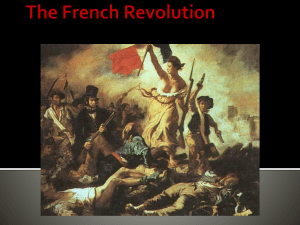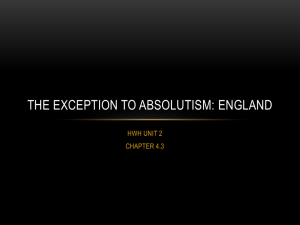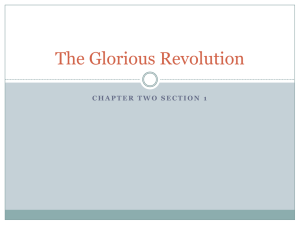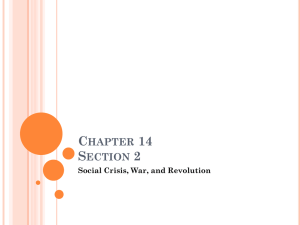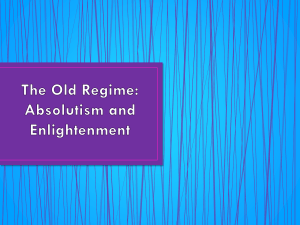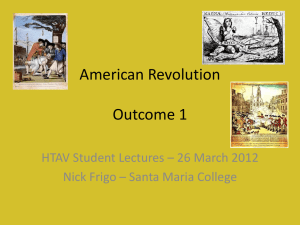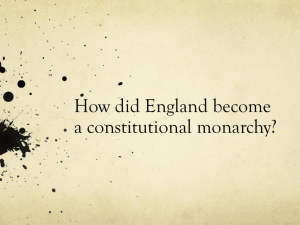Age of Revolutions and Rebellions
advertisement
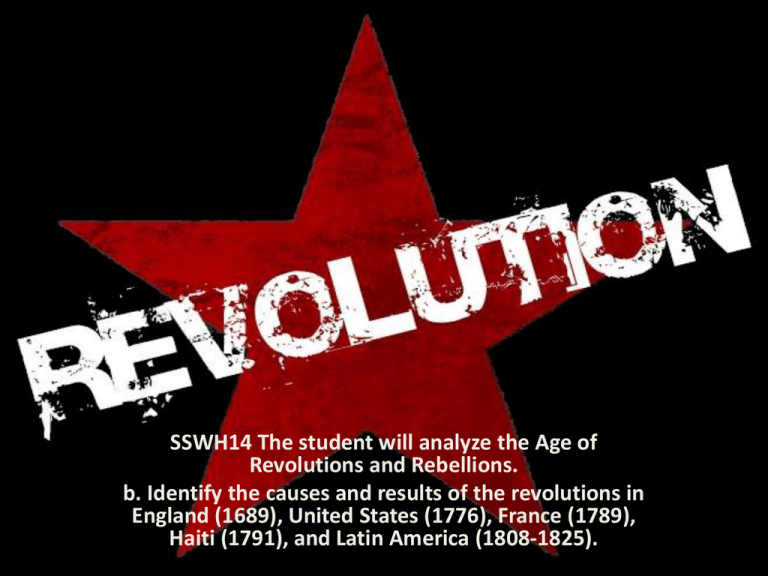
SSWH14 The student will analyze the Age of Revolutions and Rebellions. b. Identify the causes and results of the revolutions in England (1689), United States (1776), France (1789), Haiti (1791), and Latin America (1808-1825). The English Revolution – Chapter 14 Sections 2 p. 437 – 439 • Why was it fought? A struggle between the King and Parliament to determine what role each should play in governing England. The Tudors and Divine Right • Tudor dynasty came to an end with the death of Elizabeth I in 1603 • The Stuart line of rulers began with the ascension to the throne of Elizabeth’s cousin- James I, King of Scotland • James believed in the divine right of kings—Parliament disagreed and felt they shared power with the King. • Religion was an issue as well. • Puritans (Protestants in England inspired by Calvinist ideas) did not like the King’s strong defense of the Church of England • The Puritans formed an important part of the House of Commons • Charles I tried to impose more ritual on the Church of England causing many Puritans to flee to America. Civil War and the Commonwealth • 1642- The country slipped into civil war between the Cavaliers or Royalists (supporters of the King) and the Parliamentary forces (called the Roundheads because of their short hair cuts. • Parliament proved victorious, due largely to the New Model Army of Oliver Cromwell, a military genius. • Cromwell purged Parliament of any who had not supported him and the Parliament that was left had Charles executed January 30, 1649. • Abolished the monarchy and the House of Lords and declared England a republic, or commonwealth. Oliver Cromwell The Restoration • 1660- Parliament restored the monarchy in the person of Charles II • Parliament kept much of the power it had gained and continued to play an important role in government • Restored Church of England as the state religion, restricted the rights of Puritans and Catholics • Charles II was sympathetic to Catholics- his brother and the heir to the throne was a devout Catholic • When James took the throne… • Religion once again became a cause of conflict between the King and Parliament. A Glorious Revolution • In 1688, William of Orange (husband of James’ daughter Mary) invaded England • James, his wife, and infant son fled to France • January 1689, Parliament offered the throne to William and Mary • They accepted it along with a Bill of Rights • This laid the foundation for a limited or constitutional monarchy. • Toleration Act of 1689 granted Puritans but not Catholics the right of free worship. • By deposing one king and establishing another, Parliament destroyed the divine right theory of kingship. p. 539- 540 The War Begins • After the Seven Years’ War, the British wanted to get new revenues from the colonies. • In 1765, Parliament imposed the Stamp Act on the colonies. • Act required printed materials such as legal documents and newspapers carry a stamp showing that a tax had been paid to Britain • Opposition was widespread and often violent • Act was repealed in 1766 but the cause of the dispute was not resolvedNO TAXATION WITHOUT REPRESENTATION! • The First Continental Congress met in September of 1774 in Philadelphia urging colonists to take up arms and organize militias. • April 1775 in Lexington and Concord, Massachusetts fighting finally erupted • A Second Continental Congress met formed an army and made George Washington its commander in chief • July 4, 1776 the congress approved a Declaration of Independence written by Thomas Jefferson which declared the colonies free and independent states absolved from all allegiance to the British crown Foreign Support & British Defeat • French supplied the colonies with arms and money and even sent officers to help train the militias • In February of 1778, after a British defeat, the France granted diplomatic recognition to the American state. • General Cornwallis was forced to surrender to combined forces at Yorktown, causing the British to withdraw • The Treaty of Paris was signed in 1783 recognizing the independence of the American colonies • The Declaration of Independence, Constitution, Federal System, and Bill of Rights that resulted from the revolution were seen to be the embodiment of the Enlightenment’s political dreams Chapter 18 Sections 1 and 2 p. 544 – 561 • The fall of the __________________________ marked the beginning of the French Revolution. • Compared with the American Revolution it was more complex, more violent, and far more radical. • It tried to create a new political order and a new social order. Causes • Long range problems and immediate forces • Long range problem- the condition of French society; Population was divided into three estates: clergy, nobility, and commoners. This society was based on inequality. • Immediate cause- near collapse of the government’s finances Origins of the French Revolution • • • • • • • • • • • 1787- 88 Bad harvests and a slowdown in manufacturing led to food shortages, inflation, and unemployment In spite of these problems, the French government continued to spend enormous sums on wars and court luxuries Louis XVI forced to call a meeting of the Estates General (Parliament) to raise taxes. They had not met since 1614. May 5, 1789 meeting opened at Versailles, troubled from the start with a problem with voting. Traditionally, each estate had one vote allowing the first and second to outvote the third estate 2 to 1. (The third estate is comprised of 98% of the population. See chart on p. 548) The third estate demanded each person have one vote. King in favor of the current system. On June 17, 1789 the third estate met and decided to draft a constitution and called itself the National Assembly Louis XVI prepared to use force against the Third Estate but a mob stormed the Bastille marking the beginning of the French Revolution Royal authority had collapsed Popular revolutions broke out across France over the social structure and landholding system Destruction of the Old Regime • The National Assembly abolished the rights of the landlords and adopted the __________________________ • King refused to accept the Assembly’s decrees until the palace was stormed by an angry mob • National Assembly seized and sold lands of the church • Set up a limited monarchy with the Constitution of 1791 • Louis XVI attempted to flee France, but was captured and returned to Paris The Paris Commune • Defeats in war with foreign enemies and economic shortages led to new political demonstrations. • Radical political groups called the Paris Commune attacked the royal palace and Legislative Assembly and took the King captive • Forced the Legislative Assembly to suspend the monarchy and call for a National Convention to decide on the nation’s future form of government. Move to Radicalism • September 1792, the newly elected National Convention established a republic, the French republic • But once again, split into factions over the fate of the King; both groups were members of the Jacobin club – Girondins- feared mobs and leaned towards keeping the King alive – The Mountain- wanted the King dead – Mountains won! • January 21, 1793 King beheaded on the guillotine creating new enemies for the revolution • Conflicts over who ruled France internally • Murder of the King outraged royalty of Europe • A coalition formed to invade France Reign of Terror • Revolutionary Courts were set up to prosecute the enemies of the revolutionary republic. • Close to 40,000 people were killed • 16,000 including the Queen of France- Marie Antoinette died under the blade of the guillotine • Revolutionary armies would change the nature of modern warfare. • By September 1794, the Revolutionary army was the largest ever in Europe. • Important step in the creation of modern nationalism. • By summer 1794, the French had largely defeated their foreign foes. • Jacobins lost power and more moderate leaders took control. • The new constitution created in 1795 reflected the desire for stability Revolution in Haiti p. 371 and 672 • In 1791, the ideals of the American and French revolutions traveled across the Atlantic and the Caribbean to the French held colony of St. Domingue on the island of Hispaniola • Inspired by talk of freedom enslaved Africans took up arms • Led by a former slave, Toussaint L’ouverture, the rebels fought for 13 years against the French • January 1, 1804, the nation now known as Haiti became the second nation in the Americas to achieve independence from colonial rule • First independent state in Latin America Revolution in Latin America Chapter 21 Section 4, p. 672 – 673 • Napoleon’s overthrow of the monarchies of Spain and Portugal weakened their authority in their colonial empires. • Between 1807 and 1825, a series of revolts enabled most of Latin America to become independent Mexico • Led by Miguel Hidalgo, a parish priest who roused the local Indians and mestizos to free themselves from the Spanish • September 16, 1810, formed a mob army to attack the Spanish • His forces were crushed and he was sentenced to death, but his memory lived on • In 1821, Mexico declared its independence from Spain. Simon Bolivar Revolution in South America • Jose’ de San Martin of Argentina and Simon Bolivar of Venezuela are considered the Liberators of South America • Believed the Spanish must be removed from South America if any nation there was to be free • By 1810, San Martin had liberated Argentina • Bolivar began in Venezuela in 1810 and went on to lead revolts in New Granada (Columbia) and Ecuador • Surprised the Spanish and defeated them in Chile and moved on to Lima, Peru—the center of Spanish authority • Bolivar crushed the last significant Spanish army in December 1824 • Brazil gained their independence in 1822 from Portugal • The Central American states gained their independence in 1823 and broke into five republics in 1838- 1839: Guatemala, El Salvador, Honduras, Costa Rica, and Nicaragua


